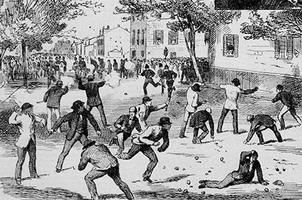This content is from a series created in partnership with Museum Services of the City of Toronto and Heritage Toronto. We gratefully acknowledge funding from the Ontario Ministry of Tourism, Culture and Sport, and the Department of Canadian Heritage.
Toronto Feature: Sectarian Conflict
"Walking for God and Raising Hell: the Jubilee Riots"
On Sunday, 3 October 1875, about 2000 Roman Catholic pilgrims left St Michael's Cathedral seeking indulgence (remission of punishments for sins after being forgiven them by doing penance) offered on the occasion of the papal jubilee. The Orange Order, famously promoting a British Protestant version of Canada, had denounced the series of pilgrimages proposed by Archbishop John Lynch. Toronto's mayor had also unsuccessfully tried to persuade the Roman Catholic Archbishop to cancel the event.
Moving south on Church Street, when the procession reached Queen Street, a volley of stones rained down on the participants and a pistol shot rang out. The pilgrims retaliated and a number of them drew revolvers and fired on the crowd. A battle for supremacy on the streets of Toronto had begun.
For more than six hours, a state of riot dominated the streets of downtown Toronto. At virtually every intersection on the route to St Mary's on Bathurst Street the pilgrims faced angry anti-processionist crowds who hurled stones and fired pistols.
The military was summoned to join the police in their efforts to keep the combating groups apart. As night fell, the rioters disbanded and peace was restored after the largest and most serious riot in the history of Toronto. While many persons were injured, no fatalities occurred. Many of the rioters who were arrested were members of the Orange Lodge.
While yet another example of sectarian conflict in Toronto, the riots were exceptional in scale, and were generally considered by most citizens to be a "day of lasting disgrace."

 Partager sur Facebook
Partager sur Facebook Partager sur X
Partager sur X Partager par Email
Partager par Email Partager sur Google Classroom
Partager sur Google Classroom





